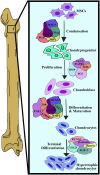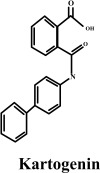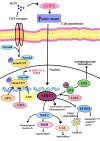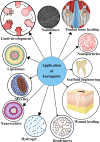Nanomedicine-Driven Approaches for Kartogenin Delivery: Advancing Chondrogenic Differentiation and Cartilage Regeneration in Tissue Engineering
- PMID: 40535835
- PMCID: PMC12174920
- DOI: 10.2147/IJN.S525580
Nanomedicine-Driven Approaches for Kartogenin Delivery: Advancing Chondrogenic Differentiation and Cartilage Regeneration in Tissue Engineering
Abstract
Articular cartilage degradation and osteocartilage defects are the most prevalent concerns that vary from localized to more systemic forms of cartilage disease. However, regulating chondrogenic differentiation within the joints remains a significant challenge. Kartogenin, a small heterocyclic compound, has recently garnered considerable attention as a potential therapeutic agent, owing to both chondrogenic and chondroprotective properties for intra-articular therapy. Initially, it was created for osteoarthritis; it has also been used to address various diseased conditions, such as the regeneration of disc and bone-tendon junctions. On top of that, it preserves the equilibrium between cartilage catabolism and anabolism, while also mitigating inflammation and alleviating pain by preventing damage induced by cytokines. To modulate tissue function and cellular behaviour, it is crucial to have sustained release of ketogenic through an appropriate delivery system. A multitude of biomaterial-based carriers have been developed for the prolonged release of kartogenin. Moreover, many biological mechanisms of action of kartogenin have been identified. The most critical molecular mechanism among them is the dissociation of filamin A from core-binding factor (CBF)-β induced by kartogenin. Filamin A subsequently translocates to the nucleus, where it engages with RUNX-1 to transcribe genes implicated in the chondrogenesis of mesenchymal stem cells. This review focuses on the development of biomaterials functionalized with kartogenin, including their structure, design, physicochemical properties, biological roles, molecular mechanisms of action, and applications in tissue engineering and regenerative medicine. In conclusion, we discussed the future possibilities and challenges posed by recent advancements in kartogenin research and their potential applications in tissue regeneration.
Keywords: Kartogenin; TGF-β; cartilage regeneration; chondrogenesis; osteoarthritis.
© 2025 Bhuyan et al.
Conflict of interest statement
The authors report no conflicts of interest in this work.
Figures









Similar articles
-
Multifunctional Biomimetic Nanomedicine for Osteoarthritis Alleviation by Mitigating Cartilage Degeneration and Promoting Cartilage Regeneration.ACS Appl Mater Interfaces. 2025 Jul 16;17(28):40288-40302. doi: 10.1021/acsami.5c10090. Epub 2025 Jul 3. ACS Appl Mater Interfaces. 2025. PMID: 40611375
-
Kartogenin Induces Chondrogenesis in Cartilage Progenitor Cells and Attenuates Cell Hypertrophy in Marrow-Derived Stromal Cells.Curr Stem Cell Res Ther. 2025;20(5):577-583. doi: 10.2174/011574888X314971240511151616. Curr Stem Cell Res Ther. 2025. PMID: 38778613
-
Construction of Cells-Membrane-Cells Living Complexes for Cartilage Repair by Enhancing the Structural Stability of Fibrous Membranes.Adv Healthc Mater. 2025 Jun;14(16):e2403656. doi: 10.1002/adhm.202403656. Epub 2025 May 6. Adv Healthc Mater. 2025. PMID: 40326193
-
Recent strategies in cartilage repair: A systemic review of the scaffold development and tissue engineering.J Biomed Mater Res A. 2017 Aug;105(8):2343-2354. doi: 10.1002/jbm.a.36087. Epub 2017 May 10. J Biomed Mater Res A. 2017. PMID: 28387995
-
Mesenchymal stromal cells-derived extracellular vesicles in cartilage regeneration: potential and limitations.Stem Cell Res Ther. 2025 Jan 23;16(1):11. doi: 10.1186/s13287-025-04135-6. Stem Cell Res Ther. 2025. PMID: 39849578 Free PMC article.
References
-
- Swain S, Priyadarshini I, Rautray TR, et al. Processing and Characterization of Materials. In: Asian Conference on Indoor Environmental Quality; 2021 December 7; Singapore: Springer Nature Singapore; 2023. doi: 10.1007/978-981-99-5509-1_5. - DOI
Publication types
MeSH terms
Substances
LinkOut - more resources
Full Text Sources

